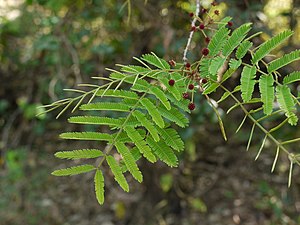Note: This is a project under development. The articles on this wiki are just being initiated and broadly incomplete. You can Help creating new pages.
Difference between revisions of "Acacia torta - Kempu Seege, Twisted Acacia"
(→Common names) |
(→References) |
||
| Line 67: | Line 67: | ||
<references> | <references> | ||
| − | <ref name="chemical composition">[https://www.indianmedicinalplants.info/herbs/index.php/a/1316-acacia-torta-roxb-craib-nikunjika-medicinal-uses-morphology-images-side-effects-pharmacology | + | <ref name="chemical composition">[https://www.indianmedicinalplants.info/herbs/index.php/a/1316-acacia-torta-roxb-craib-nikunjika-medicinal-uses-morphology-images-side-effects-pharmacology Chemistry]</ref> |
| − | <ref name="Leaf">[https://indiabiodiversity.org/species/show/228562" | + | <ref name="Leaf">[https://indiabiodiversity.org/species/show/228562"Morphology"]</ref> |
<ref name="How to plant/cultivate">[ "Cultivation"]</ref> | <ref name="How to plant/cultivate">[ "Cultivation"]</ref> | ||
Revision as of 16:08, 21 January 2020
Twisted Acacia' is a large climbing shrub grown upto 5-6m tall. Stem prickly and pubescent when young, prominently fluted and angled when old.
Contents
- 1 Uses
- 2 Parts Used
- 3 Chemical Composition
- 4 Common names
- 5 Properties
- 6 Habit
- 7 Identification
- 8 List of Ayurvedic medicine in which the herb is used
- 9 Where to get the saplings
- 10 Mode of Propagation
- 11 How to plant/cultivate
- 12 Commonly seen growing in areas
- 13 Photo Gallery
- 14 References
- 15 External Links
Uses
Emmenagogue, Anti-inflammatory, Antiseptic.
Parts Used
Chemical Composition
It contains the following contituents Tannins, triterpene alcohol, saponins of acacic acid, lupeol,acaciol.[1]
Common names
| Language | Common name |
|---|---|
| Kannada | Antarike |
| Hindi | Aila |
| Malayalam | Incha |
| Tamil | Inchakkai |
| Telugu | Nallsandra |
| Marathi | NA |
| Gujarathi | NA |
| Punjabi | NA |
| Kashmiri | NA |
| Sanskrit | Nikunjika |
| English | NA |
Properties
Reference: Dravya - Substance, Rasa - Taste, Guna - Qualities, Veerya - Potency, Vipaka - Post-digesion effect, Karma - Pharmacological activity, Prabhava - Therepeutics.
Dravya
Rasa
Guna
Veerya
Vipaka
Karma
Prabhava
Habit
Identification
Leaf
| Kind | Shape | Feature |
|---|---|---|
| Bipinnate | Alternate | Rambling shrubs; branchlets puberulus. Leaves to 24 cm long; pinnae 12 pairs; leaflets 8 x 3 mm, oblong, obtuse at apex, subcordate at base, slightly pubescent, 1-nerved from base. |
Flower
| Type | Size | Color and composition | Stamen | More information |
|---|---|---|---|---|
| Bisexual | Heads in terminal panicles | Yellow | Many | Flowers many, 3 mm long; filaments 5.5 mm long |
Fruit
| Type | Size | Mass | Appearance | Seeds | More information |
|---|---|---|---|---|---|
| Pods | 16 x 2.5 cm | flat, papery, yellowish-brown, densely glandular. |
Other features
List of Ayurvedic medicine in which the herb is used
Where to get the saplings
Mode of Propagation
How to plant/cultivate
Commonly seen growing in areas
[[:Category:Herbs that are commonly seen in the region of |]], [[:Category:Herbs that are commonly seen in the region of |]], [[:Category:Herbs that are commonly seen in the region of |]], [[:Category:Herbs that are commonly seen in the region of |]], [[:Category:Herbs that are commonly seen in the region of |]].
Photo Gallery
References
- ↑ Chemistry
- ↑ "Morphology"
- ↑ [ "Cultivation"]
External Links
- [ ]
- [ ]
- [ ]
- Ayurvedic Herbs known to be helpful to treat Emmenagogue
- Ayurvedic Herbs known to be helpful to treat Anti-inflammatory
- Ayurvedic Herbs known to be helpful to treat Antiseptic
- Herbs with Flowers used in medicine
- Herbs with Seeds used in medicine
- Herbs with common name in Kannada
- Herbs with common name in Hindi
- Herbs with common name in Malayalam
- Herbs with common name in Tamil
- Herbs with common name in Telugu
- Herbs with common name in Sanskrit
- Habit - Climber
- Index of Plants which can be propagated by Cuttings
- Herbs that are commonly seen in the region of
- Herbs
- Fabaceae



